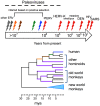Paleovirology--modern consequences of ancient viruses
- PMID: 20161719
- PMCID: PMC2817711
- DOI: 10.1371/journal.pbio.1000301
Paleovirology--modern consequences of ancient viruses
Conflict of interest statement
The authors have declared that no competing interests exist.
Figures


Similar articles
-
Paleovirology - ghosts and gifts of viruses past.Curr Opin Virol. 2011 Oct;1(4):304-9. doi: 10.1016/j.coviro.2011.06.007. Curr Opin Virol. 2011. PMID: 22003379 Free PMC article. Review.
-
Paleovirology of bornaviruses: What can be learned from molecular fossils of bornaviruses.Virus Res. 2019 Mar;262:2-9. doi: 10.1016/j.virusres.2018.04.006. Epub 2018 Apr 6. Virus Res. 2019. PMID: 29630909 Review.
-
Editorial overview: Paleovirology: the genomic fossil record, and consequences of ancient viral infections.Curr Opin Virol. 2017 Aug;25:ix-xi. doi: 10.1016/j.coviro.2017.08.002. Epub 2017 Sep 1. Curr Opin Virol. 2017. PMID: 28867332 No abstract available.
-
The genome of a Mesozoic paleovirus reveals the evolution of hepatitis B viruses.Nat Commun. 2013;4:1791. doi: 10.1038/ncomms2798. Nat Commun. 2013. PMID: 23653203
-
Paleovirology of the DNA viruses of eukaryotes.Trends Microbiol. 2022 Mar;30(3):281-292. doi: 10.1016/j.tim.2021.07.004. Epub 2021 Sep 2. Trends Microbiol. 2022. PMID: 34483047 Review.
Cited by
-
Convergence and divergence in the evolution of the APOBEC3G-Vif interaction reveal ancient origins of simian immunodeficiency viruses.PLoS Pathog. 2013 Jan;9(1):e1003135. doi: 10.1371/journal.ppat.1003135. Epub 2013 Jan 24. PLoS Pathog. 2013. PMID: 23359341 Free PMC article.
-
The importance of understanding the human-animal interface : from early hominins to global citizens.Curr Top Microbiol Immunol. 2013;365:49-81. doi: 10.1007/82_2012_269. Curr Top Microbiol Immunol. 2013. PMID: 23042568 Free PMC article. Review.
-
A cross-species view on viruses.Curr Opin Virol. 2012 Oct;2(5):561-8. doi: 10.1016/j.coviro.2012.07.003. Epub 2012 Jul 24. Curr Opin Virol. 2012. PMID: 22835485 Free PMC article. Review.
-
Long-term balancing selection maintains trans-specific polymorphisms in the human TRIM5 gene.Hum Genet. 2010 Dec;128(6):577-88. doi: 10.1007/s00439-010-0884-6. Epub 2010 Sep 2. Hum Genet. 2010. PMID: 20811909
-
When parasitic wasps hijacked viruses: genomic and functional evolution of polydnaviruses.Philos Trans R Soc Lond B Biol Sci. 2013 Aug 12;368(1626):20130051. doi: 10.1098/rstb.2013.0051. Print 2013 Sep 19. Philos Trans R Soc Lond B Biol Sci. 2013. PMID: 23938758 Free PMC article. Review.
References
-
- Katzourakis A, Rambaut A, Pybus O. G. The evolutionary dynamics of endogenous retroviruses. Trends Microbiol. 2005;13:463–468. - PubMed
-
- Bannert N, Kurth R. The evolutionary dynamics of human endogenous retroviral families. Annu Rev Genomics Hum Genet. 2006;7:149–173. - PubMed
-
- Salemi M, Desmyter J, Vandamme A. M. Tempo and mode of human and simian T-lymphotropic virus (HTLV/STLV) evolution revealed by analyses of full-genome sequences. Mol Biol Evol. 2000;17:374–386. - PubMed
Publication types
MeSH terms
Grants and funding
LinkOut - more resources
Full Text Sources

